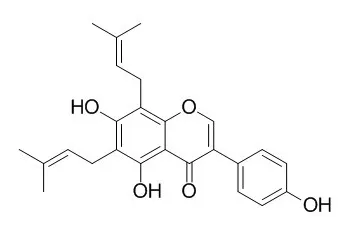| In vitro: |
| Phytother Res. 2011 Jan;25(1):46-8. | | Antibacterial activity of flavonoids from the stem bark of Erythrina caffra thunb.[Pubmed: 20623615] | The antibacterial activity of the stem bark of Erythrina caffra Thunb. was investigated against different bacterial strains.
METHODS AND RESULTS:
The antibacterial activity was determined by a micro broth dilution assay. Antibacterial compounds were isolated and identified using a Bruker Avance III LPO NMR spectrometer. Four known flavonoids, abyssione-V 4'-O-methyl ether, 6,8-Diprenylgenistein, alpinumisoflavone and burttinone, were isolated.
CONCLUSIONS:
All the compounds were active against both Gram-negative and Gram-positive bacteria. The minimum inhibitory concentration values obtained (MIC) ranged from 3.9 μg/mL to 125 μg/mL.
This is the first report of antibacterial activity of burttinone and the isolation of these compounds from E. caffra. | | Caries Res. 2015;49(1):78-89. | | In vitro antimicrobial activities of 1-methoxyficifolinol, licorisoflavan A, and 6,8-diprenylgenistein against Streptococcus mutans.[Pubmed: 25531232] |
METHODS AND RESULTS:
Three antimicrobial flavonoids, 1-methoxyficifolinol, licorisoflavan A, and 6,8-Diprenylgenistein, were isolated from the CLE. We found that the three flavonoids and CHX had bactericidal effects on S. mutans UA159 at the concentration of ≥4 and ≥1 µg/ml, respectively. The purified compounds completely inhibited biofilm development of S. mutans UA159 at concentrations over 4 μg/ml, which was equivalent to 2 μg/ml of CHX.
CONCLUSIONS:
Confocal analysis showed that biofilms were sparsely scattered in the presence of over 4 μg/ml of the purified compounds. However, the three compounds purified from CLE showed less cytotoxic effects on NHGF cells than CHX at these biofilm-inhibitory concentrations. | | J Nat Prod. 2014 Mar 28;77(3):521-6. | | Pyrano-isoflavans from Glycyrrhiza uralensis with antibacterial activity against Streptococcus mutans and Porphyromonas gingivalis.[Pubmed: 24479468] |
METHODS AND RESULTS:
Continuing investigation of fractions from a supercritical fluid extract of Chinese licorice (Glycyrrhiza uralensis) roots has led to the isolation of 12 phenolic compounds, of which seven were described previously from this extract. In addition to these seven metabolites, four known components, 1-methoxyerythrabyssin II (4), 6,8-Diprenylgenistein, gancaonin G (5), and isoglycyrol (6), and one new isoflavan, licorisoflavan C (7), were characterized from this material for the first time. Treatment of licoricidin (1) with palladium chloride afforded larger amounts of 7 and also yielded two new isoflavans, licorisoflavan D (8), which was subsequently detected in the licorice extract, and licorisoflavan E (9). Compounds 1-9 were evaluated for their antibacterial activities against the cariogenic Streptococcus mutans and the periodontopathogenic Porphyromonas gingivalis.
CONCLUSIONS:
Licoricidin (1), licorisoflavan A (2), and 7-9 showed antibacterial activity against P. gingivalis (MICs of 1.56-12.5 μg/mL). The most potent activity against S. mutans was obtained with 7 (MIC of 6.25 μg/mL), followed by 1 and 9 (MIC of 12.5 μg/mL). This study provides further evidence for the therapeutic potential of licorice extracts for the treatment and prevention of oral infections. |
|






 Cell. 2018 Jan 11;172(1-2):249-261.e12. doi: 10.1016/j.cell.2017.12.019.IF=36.216(2019)
Cell. 2018 Jan 11;172(1-2):249-261.e12. doi: 10.1016/j.cell.2017.12.019.IF=36.216(2019) Cell Metab. 2020 Mar 3;31(3):534-548.e5. doi: 10.1016/j.cmet.2020.01.002.IF=22.415(2019)
Cell Metab. 2020 Mar 3;31(3):534-548.e5. doi: 10.1016/j.cmet.2020.01.002.IF=22.415(2019) Mol Cell. 2017 Nov 16;68(4):673-685.e6. doi: 10.1016/j.molcel.2017.10.022.IF=14.548(2019)
Mol Cell. 2017 Nov 16;68(4):673-685.e6. doi: 10.1016/j.molcel.2017.10.022.IF=14.548(2019)